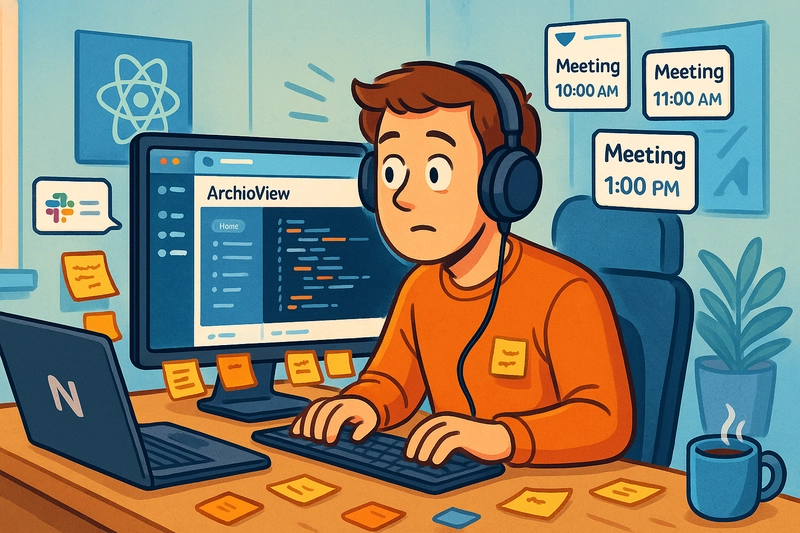When I first stepped into a frontend lead role, I thought my biggest contributions would come from writing cleaner code, refactoring smart components, and shaping the architecture.
And sure, those things mattered.
But over time, I realized something unexpected: the work that made the biggest difference wasn't visible in Git history. It wasn't in the commits, or even on the JIRA board.
It was in the quiet things, the moments between coding, that kept the team moving forward.
This is about that work. The kind that doesn't make it into changelogs but still changes everything.
📌 TL;DR
Being a frontend lead isn't just about writing better code; it's about enabling others to write better code, too.
Much of the real work happens outside of pull requests: unblocking teammates, guiding architecture decisions, mentoring quietly, and translating between product and dev.
Documentation, process, and internal advocacy often feel thankless, but they compound over time and keep the team moving.
You become the calm in the chaos: protecting focus, providing clarity, and making sure people have what they need to do their best work.
It doesn't always look like leadership from the outside, but the impact is real.
You're not just leading code, you're leading clarity
A big part of the job is just helping the team know what the hell is going on.
Product wants X. Design gives you a Figma file full of "magic." Developers are deep in PRs. Everyone's moving but not always in the same direction.
🗣️ As a lead, you're the translator. You speak product, design, and dev, and you help each side make sense to the others.
You break vague desires into actionable work.
You catch misaligned assumptions before they burn.
You fill in the gaps that everyone assumed someone else would fill in.
You explain "why we're doing this now" five different ways to five different people.
Some days, this feels like being the only one who read the manual. Other days, it's more like writing the manual while the game is already in progress.
📝 Invisible task: maintaining the team wiki or architecture docs that everyone forgets until they're absolutely lost.
Architecture isn't just diagrams, it's social
Yes, architecture is components and state management and API boundaries.
But it's also culture.
It's in how people write code when no one's watching. It's in whether developers follow the "good" pattern or the one that got them through the ticket fastest. It's in how much mental resistance a new dev feels when opening a feature folder.
✍🏻 As a lead, you're nudging the architecture constantly. Not with sweeping rewrites, but with comments like:
"Let's move this to a hook"
"This feels like it belongs in a feature module"
"We should wrap this in our reusable API pattern"
Architecture decisions are easy. Getting people to consistently use them is the real work.
Mentorship hides in the gaps
It's not always about talks or pair-programming (though those help). It's in the extra context you add to a code review comment. The time you take to rewrite a confusing ticket. That moment you decide not to fix something yourself so a junior dev can learn how.
Sometimes, mentoring means stepping back, even when it would be faster to just do it yourself.
Other times, it's listening to someone rant about a weird bug just long enough for them to solve it out loud.
🧠 Invisible work is being the person who makes the team smarter without making them feel smaller.
Documentation is boring until it saves the day
I've spent hours writing internal docs that no one noticed... until the one time someone onboards, or breaks a deployment, or asks "where's the config for that?"
📖 Maintaining a team wiki or system overview isn't a perk, but it's the kind of work that pays off over and over again.
A shared architecture overview
Deployment steps with edge cases included
Clear standards for component structure, file naming, API access
Clear steps of branching and commit messages and git flow
Writing it down gives the team fewer reasons to block you and gives you more time to lead, not babysit.
📚 Bonus points if you actually remember to update the docs after a refactor.
You become a developer advocate inside your team
👩🏻💼 One of the most valuable (and underestimated) parts of being a frontend lead is standing up for developer experience.
That might mean pushing back on:
UX decisions that ignore real-world behavior
Product deadlines that leave no time for testing
Platform or tooling decisions made without frontend in the room
It also means saying: "We need time to clean this up." Or "This quick fix will become tech debt in a sprint." Or just: "Let me explain how this impacts DX."
💬 You end up being the voice that helps non-devs understand why dev things matter and helps devs feel heard.
The process isn't sexy, but it scales
When you help shape how the team runs (standups, reviews, deployments, testing), you're not just "keeping things organized."
🧘🏻♀️ You're reducing cognitive load. You're avoiding bugs before they happen. You're letting people focus on their work instead of wondering what's expected.
Some of the best improvements I've seen came from small process tweaks:
Async check-ins instead of daily calls
Using staging deployments for QA
Making Storybook part of the release flow
Automating changelogs
Creating a checklist for Definition of Done
🛠️ Process isn't about control. It's about flow.
Defending focus is part of the job
🔔 Focus is fragile. Slack pings, vague priorities, "quick requests" - it all adds up.
Sometimes, your job as a lead is simply protecting space for others to work. Saying "not now" so someone can finish what they're building. Blocking distractions. Asking the product team to hold off while the devs finish the current release.
🏅 You might not write a line of code that day, but if your team gets to ship without interruption, you've done your job.
Final thoughts: the best work doesn't always have a commit hash
A lot of frontend leadership isn't about bold architecture changes or fancy patterns.
It's about the dozens of quiet decisions that help the team ship better software.
It's nudging, guiding, unblocking, translating, listening, writing, and occasionally... just staying out of the way.
This work is invisible. But its impact is everywhere.
💬 What kind of "invisible work" do you find yourself doing as a lead?





Top comments (0)